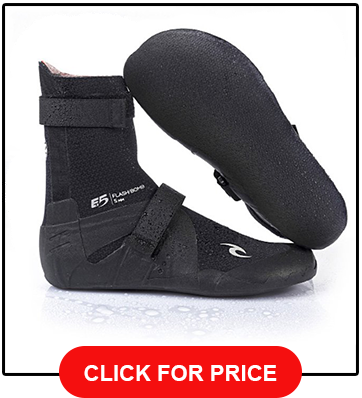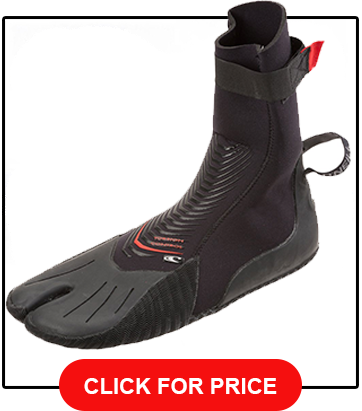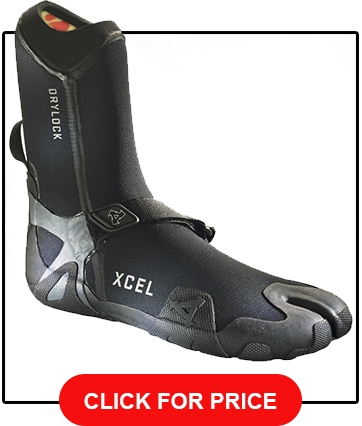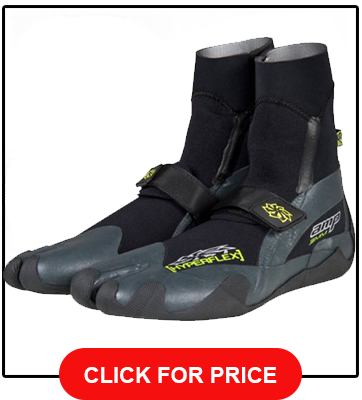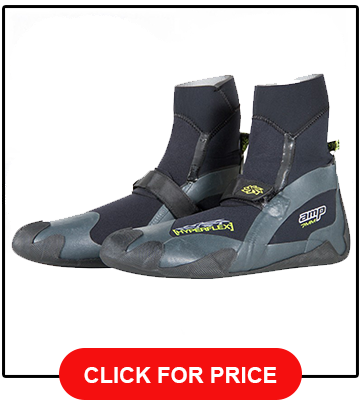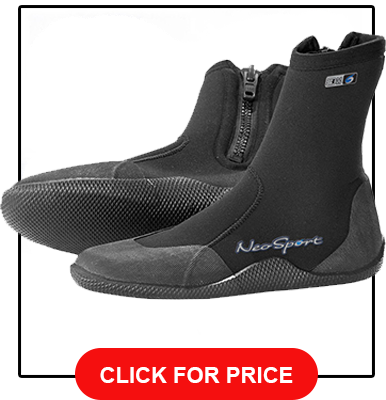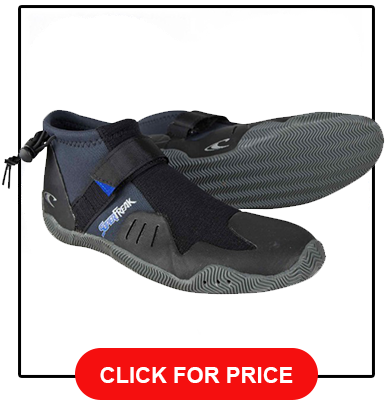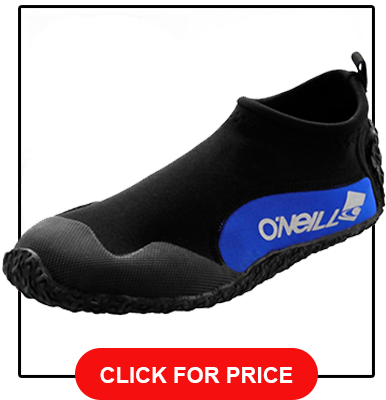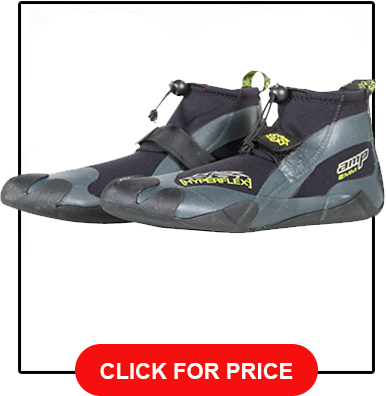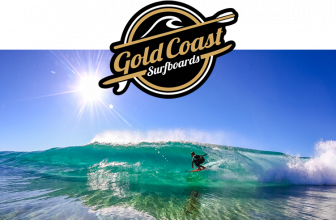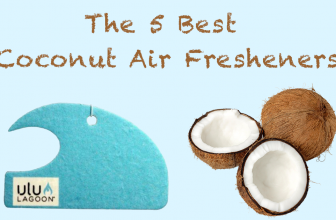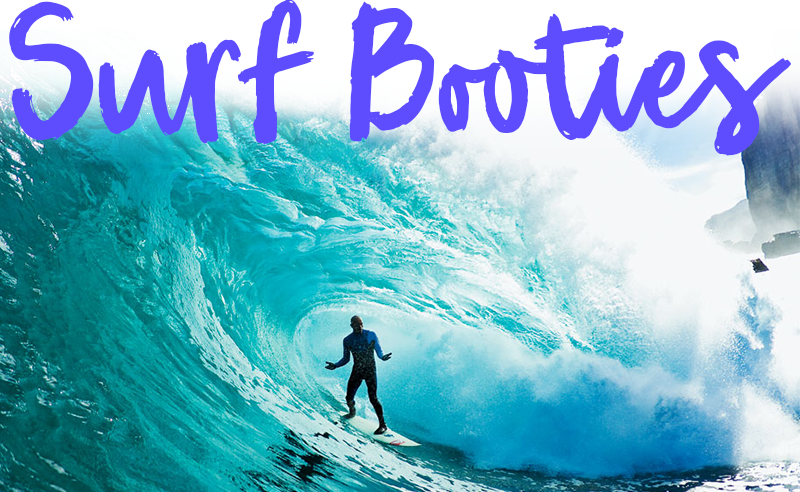
At A Glance: Our Top Picks for Surfing Booties
As a surfer, you are most likely searching for the best and warmest wetsuits rather than the best surfing booties.
But here's the problem...
More...
...Even your 6mm neoprene wetsuit with fleece quick dry insulation and a hooded design won’t protect your little toes from the iciness of the harsh winter water.
Surfing booties have definitely become a regular part of a cold-water surfer’s ensemble in modern times and, at this point, everyone should have a pair.
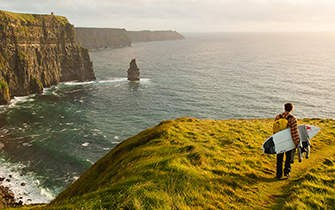
Would you rather be able to surf long hours in the coldest of temperatures with no problem or have the fear of completely losing feeling in your feet to find that you can’t even get up properly on your board?
With all the different surfing booties on the market, it can be difficult to make the right choice based on your needs.
The good thing is, we’ve made a list of our top 10 choices below to keep your feet warm and comfortable in your own personal environment!
Read below to see the top 10 plus how to choose the perfect pair for yourself:
QUICK OVERVIEW: Our Top Picks for Surfing Booties
| IMAGE | PRODUCT | |
|---|---|---|
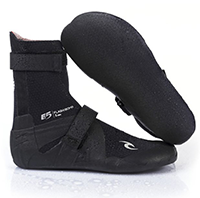 | Our Top Pick
| VIEW ON AMAZON → |
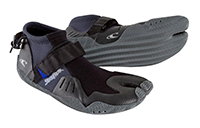 |
| VIEW ON AMAZON → |
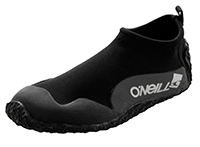 |
| VIEW ON AMAZON → |
Top 10 Best Surfing Booties
#1 Choice - Rip Curl Flash Bomb Hidden Split Toe
5 Star Editorial Review!
The Rip Curl Flash Bomb Hidden Split Toe is the perfect bootie for surfers on the grind and is easily one of the best on the market.
Plus, we all know that Rip Curl is a well-respected company when it comes to any surfing product.
These booties are constructed with a 3mm flash-lined neoprene for ultimate protection and warmth. It is the same famous neoprene that you’ll find on all of Rip Curl’s wetsuits.
The booties come with a super soft heel cup and a hidden split toe. The hook-and-loop closure design makes sure that any unwanted moisture or water is kept out. Beyond those features, the stitch-less compression strap keeps it secured to your foot while offering great mobility.
The soles on the Flash Bomb are very thin and soft with rubber gaps cut out for better board feel and grip. Some people feel that booties disconnect them from their boards so the thin design is an excellent compromise.
If you’re looking for a great surfing bootie with style, comfort, and durability, this is the one for you!
#2 - O'Neill Wetsuits Men's 3 mm Heat Split Toe
One of our personal favorites here at Blade Scout is the O’Neill Heat Split Toe.
These boots come with a split toe design to keep your toes feeling free and loose on your board. Some people complain about their leashes getting caught in-between their toes, though those cases are few and far between.
The soft, fluid flex neoprene design is made with O’Neill’s quality craftsmanship and will easily survive for years to come in the harshest of conditions.
The boots are strapless, though come equipped with glued and bind-stitched seams to keep them safe and secure on your feet, as well as to keep water and moisture out.
If dryness, durability, and a comfortable fit are important to you, we can’t recommend anything like the O’Neill Heat.
If you are surfing in ultra cold waters, the 3mm design might be a bit thin and you should probably try something else.
#3 - Xcel Mens 13 Bgr
If you’re looking for some booties with a great board feel and an ultra comfortable design, look no further than the Xcel Mens 13 Bgr.
These boots are made with a 3mm, 100% ultra-stretch neoprene that makes them great for even wide feet!
Even beyond the flex capabilities, the TDC thermo drylock celiant low pile is a very lightweight and naturally hydrophobic material that will dry fast.
Though not the most durable on the bottom, the booties do come equipped with a thin sole that gives you excellent board feel, as well a solid split toe design to reduce leash hangups.
The Taitex seal does however give it some extra durability above the sole, but is also there to make sure that water doesn’t get in so you can keep your session dry.
With some of the warmest lining on our list with infrared converting technology, these booties have insane performance that will keep you surfing all day!
#4 - Hyperflex AMP 5mm Split Toe
As with every product in the Hyperflex brand, these booties are built with high-performance quality in mind.
With over a decade of manufacturing, Hyperflex has improved these booties with better fit, finish, warmth, and comfortability. These split-toe booties come with AMP foam neoprene making them very warm and comfortable with an insanely flexible feel for a wide range of motion and control.
The GBS seams are all double-glued and blind-stitched with FusionWeld liquid molecular bond and a high-stretch tapered panel sewn onto the boot entry. Water is no match for these bad booties.
The Hyperflex AMP Split Toes have a special vulcanized heel lock membrane structure connects to the upper arch strap for a snug fit and extra support. With 3mm and 5mm designs, you have the option to choose which one works best for you!
With durability, flexibility, grip, feel, and warmth, the Hyperflex Amp Split Toes are incredibly well rounded booties that will keep you nice and toasty.
#5 - Hyperflex AMP 5mm Round Toe Boot
The second pair of Hyperflex booties on our list is the HyperFlex AMP 5mm Round Toe Boot. If you’re looking for solid, high-performance surf booties with tons of awesome features, these are the booties for you!
These booties come equipped with double-glue and blind-stitched seams that are stitched with a single needle so there are no holes punctured for ultimate water protection.
The HyperFlex DiamondSkin sole is made up of diamond-shaped channels that provide constant grip and traction without losing the feel that so many surfers love.
The round toe design may be a bit less balanced, though the pro is that your leash will never get caught. Like the Split Toe, the Round Toe comes with the same vulcanized heel lock membrane to allow you to adjust it best for proper fit and support.
Along with the TaperLock closure, the P4 thermal lining, and the Exoshell+ Membrane, these booties have all the bells and whistles you’ll ever need.
#6 - NeoSport 3mm Hi Top Zipper
These booties are great because they are simple, durable, reliable, and they come at an excellent price!
Not only are they great for surfing, these bad boys are designed for almost any watersport you can think of from wakeboarding to kayaking. The beefy number 10 zipper is built to keep water out, and in turn, keep your feet toasty warm.
We absolutely love the durable traction sole on the bottom of these booties.
Light enough to shred, yet heavy duty enough for the ocean floor, these booties are made with a low profile stitching that provides maximum comfort without having to sacrifice durability.
Even though these booties are strapless, they come with a very stretchy neoprene that keep them snug around your feet while never getting in the way of foot movement.
#7 - O'Neill Superfreak Tropical 2 mm Split Toe
At an incredible price point for a reputable brand, and perfect for those in warmer waters, the O’Neill Superfreak Tropical 2mm Split Toe booties are an incredible option for surfers.
These booties are very well made with a heavy-duty rubber sole for the perfect amount of traction when you’re on your board.
One of the things that we love about these boots is the low cut ankle design that acts as a great companion for those in tropical climates.
They’re also equipped with rapid drain ports on the side so that water drains out quickly and efficiently because who wants to be floating atop their board?
The durable fluid foam nylon keeps them from wearing as you paddle out. If you’re surfing colder waters, these are definitely not the booties for you!
#8 - O'Neill Superfreak Tropical 2mm Round Toe
If you want a pair warm water booties without the split toe design, the O’Neill Superfreak Tropical 2mm Round Toes are the perfect booties for you.
These booties are very lightweight and ultra flexible. O’Neill found the perfect balance between board feel and durability with these guys.
The foxing rubber outsole is hardcore enough to stand just about any coral reef. These booties are very easy to get on with their low cut design and will offer a great fit that you can trust for many years to come.
If you’re living in a warm region such as California, we can definitely recommend these booties. Other features include ankle cinch cords, forefoot straps, and drain holes to release water quickly.
#9 - O'Neill Wetsuits Mens Reactor Reef 2mm
These Reactor Reef booties are also perfect for warmer climates. The synthetic mesh neoprene is at 2mm, which is thinner than most standard bootie models.
Even though these booties are very light, the sole is surprisingly strong. Don’t go on a hike with these though! In terms of surfing, the downside is that they are not as stable as most split toe booties or round toe cousins.
They also do not come equipped with drain holes on the side, though the liner helps them to fit pretty tight so not much water flows in.
Think of these more like your standard water shoes that you’d find at your local beach shop or big box store.
With great grip and a simple design, these are perfect for someone who isn’t an everyday surfer, though always finds themselves in the water wanting a good pair of shoes to bring in.
#10 - Hyperflex AMP 2mm Low Reef
The last pair of Hyperflex booties on our list are ideal for warmer climates and high-performance surf.
Made with their heavy-duty AMP-foam neoprene, these booties are capable of withstanding a ton of wear and tear, and basically waterproof with their single-needle engineering method, to make sure that water doesn’t leak in.
The AMP-foam neoprene is incredibly warm, while, at the same time, comfortable and flexible, for a maximum range of motion.
The Hyperflex Diamond-Skin soles provide constant board grip, feel, and traction, while also providing protection from harsher elements that may try to puncture through them.
Round Toe vs. Split Toe Booties?
Round Toe and Split Toe refers to the footbed part of the bootie. The Split Toe booties are split into two sections, one for your big toe, and one for the rest of your toes. One of the biggest advantages with a split toe design is that it gives you a more natural feel for better balance. It works just like a human foot would work. Not only that, but it locks your feet to the insides of the boot better so you don’t experience any internal slide that could possibly cause you to fly off your board. Some people feel that this design is a little less comfortable because it forces your toes apart, though it is fairly easy to get used to after a few runs.
Round Toe booties are built like your everyday pair of shoes where all of your toes rest in the same area of your footbed. One of the biggest advantages to these boots is that your feet will be warmer all together. It’s the same reason why your hands are much warmer when they are in mittens rather than gloves. The disadvantage to these booties is that they aren’t as secure. Surfers will forever argue for one or the other, though it kind of comes down to semantics. Both kinds of booties work great so get whatever makes you comfortable!
Choosing the right size
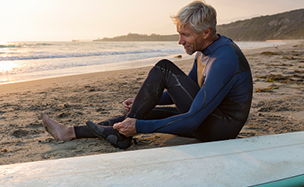
Many people seem to be confused about how their surfing booties should fit.
It’s fairly simple.
You’ll want your booties to be snug around your feet and ankles.
Now you don’t need them to be so tight that you lose feeling in your feet or that your feet feel smashed up in a neoprene chokehold, but you definitely don’t want your feet to be sliding around inside of them or have water leaking in while you’re out riding.
Sometimes people make the mistake of buying booties that are too small to find that it actually makes their feet colder. This is because it cuts off the circulation in your feet and stops warm blood from flowing in and out.
On the other hand, if your booties have the clown shoe look, it’s more than likely that your feet will be flopping around inside of them until you womp on a wave because you lost your balance and tripped over them.
A bigger bootie is also terrible for keeping out water, making the whole utility of the shoe pointless.
Most bootie sizes are fairly relative to shoe sizes, some being sized for your exact shoe size, and some being a size or half size bigger or smaller.
All of the manufacturers listed have bootie sizing charts on their websites that we highly recommend you read over before you make your purchase.
Choosing The Right Booties For Your Situation
Water Temperature
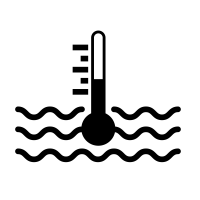
The majority of booties that you’ll see are either manufactured in 3mm, 5mm, and 7mm sizes. It’s pretty self-explanatory, the thicker the boot, the better for colder waters.
During the California summer time, the water temperatures can get up to around 60°F which some might say makes booties an unnecessary accessory.
If you’re someone who can’t stand to have cold feet, maybe doesn’t have great circulation, or can’t stand to be barefoot on the ocean floor with the creepy crawlies of the deep, 3mm booties are perfect for you.
If you’re surfing the northern New England coastline in January where waters are mid-30s on average, maybe shoot for the 5mm boots.
If you’re bad enough to surf in many of the world’s coldest surfing spots such as Lofoten, Norway or Reykjavik, Iceland, you might want to strap on a pair of 7mm booties to keep your feet from freezing in the 23°F water.
Terrain
Surfing out in San Diego on La Jolla Shores is a walk in the park.
A sandy beach and 70°F water is the perfect recipe for throwing on your board shorts and paddling out.
However, though it is only 8 hours away, if you’re surfing spots like Fort Point in San Francisco, with a line of rip rap rocks that you have to hike down to get out there, you’ll probably want something to protect your feet on the way down and back.

Thickness

Not only does the thickness of your booties determine how warm they are, but they can also determine how you surf.
Many surfers will swear by thinner booties, as it is the closest thing to the feeling of gripping your board without any footwear.
It is definitely important to have some extent of board feel when riding to stay connected.
The issue with thinner booties is they typically aren’t very durable.
Between swimming in saltwater, walking down rocky terrains to your favorite spot, or hopping through unforgiving coral reefs, thinner booties typically need replacement after only a season.
Tons of professional surfers are constantly replacing their booties when they’re thin, though most regular surfers aren’t quite at the financial level to do that, so it is definitely something to consider.
Materials Used
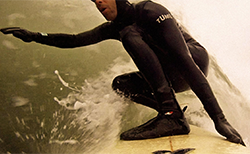
Most surfing booties on the market are made with a double-sided neoprene.
One of the sides of neoprene is inside the boot.
This makes them very warm and durable.
Neoprene is the same material that you will find on your typical wetsuit.
Neoprene is great for resisting weather degradation, resisting oil or chemical spills, use in a wide range of temperatures, and being physically tough in general.
It is the standard for pretty much all surf and water wear these days.
Recently, companies have begun manufacturing latex-dipped neoprene for their booties.
It makes the booties very light and flexible and only shows the single-lined layers of neoprene on one side.
These boots are great for surfers who are looking for a better board feel, as it helps to increase the sensation of being barefoot for performance and stability.
The one issue with these kinds of booties is that they aren’t very durable and typically waste away after a solid season of surfing.
If we can recommend our favorite type of booties all around, they would definitely be the double-lined neoprene booties.
Taking Care of Your Surf Booties
Think of caring for your surf booties like you would care for your wetsuit.
Make sure that after each session, you rinse them with fresh, cold water and hang them out to dry in a place that is shady.
Neoprene and the sun don’t go well together.
Plus, keeping them crammed into a little bag or the back of your care is a surefire way to get moldy booties.
Remember, nobody likes a moldy bootie.
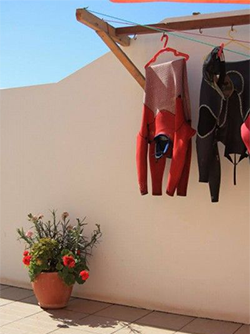
Frequently Asked Questions
Can I Wear Thermal Sock Or Wool Socks Under My Booties For Extra Warmth, Protection, and Fit?
Absolutely! Having a great thermal or wool sock is the perfect way to get some extra warmth, as well as stop the dreaded neoprene rub after a good while out in the water. They also can help make up for extra room inside your booties if your foot is at an in-between size where the booties don’t fit perfectly. If your booties aren’t as high cut to protect your ankles from the icy cold water, longer socks can act as a shield. It also makes it much easier to slide on your booties or wetsuit because it doesn’t get caught on your feet. If you are thinking about wearing some socks, you’ll want to make sure that they are wool, polypropylene, or some other material that won’t get too wet or cold. Cotton is not a good choice. Lastly, for the purpose of staying comfortable, if you want to wear socks, wear them with round toe booties. Wearing socks with split toe booties are like wearing socks while slipping into flip-flops.
Should I Still Wax My Board If I Have Booties?
Some surfers feel that booties give them an intense grip that makes it difficult to move freely up and down the board. The issue is that those surfers wax their boards as if they were standing on them with their bare feet. If you choose to wear booties out in the surf, you should have the most minimal amount of wax on your board possible. This will ensure ease in maneuvering across your board while still having the ability for a sturdy grip.
How Should I Store My Booties?
Booties can be stored in any place that is cool, dark, and dry. You can either lay them on their sides or stand them upright when they are done drying. Don’t ever rest anything on top of them as this can cause the neoprene material to crease, bend, and eventually crack. It sometimes helps to put some sort of tissue paper or newspaper inside of them as well so they retain their shape over time. Whatever you do, make sure they are nice and dry before you decide to store them away.
What Can I Do To Make Sure I Get Booties That Don’t Fill Up With Water?
Your booties will have some water in them after no matter what kind you get. Too much water, however, can weigh you down and give you cold feet and legs that make it difficult to surf with. Firstly, you’ll want to buy the right size. We can’t stress enough that buying booties are too big will not be helpful in any way. If you can, we recommend physically trying a pair on before making your purchase. Secondly, we recommend buying a pair of booties with extra straps or ties that adjust around the ankle or top part of your foot. These are made to keep out extra water. If you do all these things and you’re still getting water in there, check your wetsuit. It could be an issue of your wetsuit being too big for you.
What Are The Best Kind Of Seams On Surfing Booties?
We find that the best, most reliable seams for minimal water entry are double-glued, blind-stitched, and taped seams. It is very common to see bootie manufacturers designing with these features in mind because it is the best design for ultimate waterproof protection.
Are Booties Really Necessary?
This totally depends on your situation. They are a personal preference to many surfers, though we recommend that everyone have a pair in their surfing arsenal, as you never know what spot you’ll end up at. There are many places that have unforgiving reefs that hurt to walk across when it is low tide. If you have solid booties, they can save your feet from cuts, or even infections because of those cuts.
Secondly, if you’re a surfer who has experienced their feet going numb after a 30-minute session, you know that booties could be a lifesaver. There’s no reason to let something like cold feet get in the way of you having a good day out in the water. If you’re surfing in waters that are above 65°F, you probably do not need booties. This totally depends on your personal resistance to cold water and weather.
Final Thoughts
Surfers definitely have a love/hate relationship with booties.
They certainly haven’t elevated themselves into the realm of cool surf products yet, though they beat walking a mile over tiny, stinging rocks when your feet have barely any sensation in them.
Even if you’re not a surfer, having a pair of booties for any watersport, or even just paddling around in the sea, is a great way to keep your feet warm and safe.
Having a rubber sole is excellent for gripping onto your board, rocks, or reef.
Prices, styles, and features vary greatly between all the different surfing booties out there, so we definitely recommend doing your research before making your purchase.
In all, learn to embrace the surfing bootie! They are the future of cold water surfing.

